Huayna Picchu (también “Wayna Picchu”) es el pico empinado detrás de Machu Picchu que ves en la clásica foto de postal. La caminata es corta pero intensa, con escalones de piedra estrechos, algunos tramos aéreos y una gran recompensa en la cumbre. Actualmente, el acceso a Huayna Picchu es por el Circuito 3 → Ruta 3-A (Montaña Huayna Picchu), con dos grupos de ingreso, 07:00 y 09:00, y una cuota diaria estrictamente limitada.
Esta guía te explica paso a paso cómo reservar en el sitio oficial de entradas, cómo es realmente el sendero, cuánto tarda y si te conviene elegir Huayna Picchu, Montaña Machu Picchu o Huchuy Picchu. Mantenemos esta página actualizada y verificada con las últimas normas oficiales sobre circuitos y aforo, para que planifiques con confianza.
Boleto de ingreso a Huayna Picchu: Circuito 3 & horarios
El Circuito 3 está dividido en cuatro rutas, y Huayna Picchu es la Ruta 3-A. Recorre las zonas más sagradas e importantes que usó la realeza inca, como el Templo del Sol, la Casa del Inca y el Templo del Cóndor. Este circuito exige poco esfuerzo físico. Si decides subir a las montañas (Huayna Picchu o Huchuy Picchu) o visitar la Gran Caverna, necesitarás más tiempo y un mayor esfuerzo.
- Ruta 3-A: Montaña Huayna Picchu
- Ruta 3-B: Ruta diseñada por la realeza
- Ruta 3-C: Ruta Gran Caverna (solo disponible en temporada alta)
- Ruta 3-D: Ruta Huchuy Picchu (solo disponible en temporada alta)
Circuito 3-A (Huayna Picchu)
Cada día, 350 personas suben esta montaña (la cifra puede variar según la temporada), divididas en 2 turnos (7:00 a. m. y 9:00 a. m.), y los boletos se agotan rápido. Por ello, debes reservar con bastante anticipación. Cada boleto cuesta 200 soles.
Este boleto también te permite ingresar a Machu Picchu y recorrerlo por el Circuito 3 antes de subir la montaña. El Circuito 3 pasa por la parte baja de la ciudadela inca y te muestra zonas interesantes como:
- Plaza Central (13)
- Templo del Sol
- Doce Vanos (9)
- La Roca Sagrada (8)
- Los depósitos (10)
- Espejos de Agua (11)
- Templo del Cóndor (12)
El Circuito 3 te permite explorar la zona central de Machu Picchu, donde se encuentran los puntos más importantes y exclusivos, como el Templo del Sol, el palacio del Inca y las fuentes de agua ceremoniales.
Ten en cuenta
Los boletos para la Montaña Huayna Picchu permiten ingresar por la parte baja de Machu Picchu (Circuito 3) y no dan acceso a la parte alta (Circuito 1), donde se toman las fotos clásicas, ni al circuito clásico (Circuito 2), donde se visitan las zonas más populares de la ciudadela.
Recuerda: con estos boletos de montaña no se permite el reingreso, mucho menos cambiar de un circuito a otro a mitad de la visita o retroceder. Los guardaparques están muy atentos a estas infracciones.
Si quieres recorrer todo el sitio y tomar fotos desde la parte alta (Circuito 1), deberás comprar un boleto regular de Machu Picchu por separado por 152 soles.
Horarios de ingreso a Huayna Picchu
Huayna Picchu tiene dos grupos de ingreso: 07:00 y 09:00. La caminata toma unas 2–3 horas ida y vuelta, incluyendo breves descansos y tiempo para disfrutar las vistas desde la cumbre.
Si visitas Machu Picchu y subes Huayna Picchu el mismo día, calcula 6–7 horas en total. Esto incluye el bus y sus colas, el recorrido por el Circuito 3 hasta el control, el ascenso y descenso, y la salida en un solo sentido de la ciudadela.
| Primer turno - 07:00 a. m. | Segundo turno - 09:00 a. m. |
Este boleto te permite ingresar a la ciudadela de Machu Picchu de 7:00 a. m. a 7:30 a. m. y, recorriendo el Circuito 3, ingresar a Huayna Picchu de 8:00 a. m. a 9:00 a. m. Desde la puerta principal demora entre 45 minutos y 1 hora llegar al ingreso de Huayna Picchu recorriendo el Circuito 3. Luego, la subida toma aproximadamente 1 hora y un tiempo similar para bajar; con paradas puede tomar alrededor de 3 horas, y después otros 45 minutos para salir de Machu Picchu. | Este boleto te permite ingresar por la puerta principal de Machu Picchu a las 9:00 a. m. hasta las 9:30 a. m. Luego deberás recorrer el Circuito 3 y entrar por la puerta de Huayna Picchu de 10:00 a. m. a 11:00 a. m. Hacer Huayna Picchu en el segundo turno suele ser la mejor opción, ya que hay más probabilidad de buen clima y vistas despejadas. Sin embargo, debes considerar los horarios de tu tren de regreso y las colas largas del bus para salir de Machu Picchu. |
Recomendado para:
| Recomendado para:
|
Precio de entradas a Huayna Picchu
Puedes comprar las entradas para la montaña Huayna Picchu en la web oficial, en puntos autorizados de venta en Cusco o con nosotros. Revisa nuestras opciones de entradas y tours a Machu Picchu. Los precios se muestran en soles peruanos, la moneda local.
Extranjeros | Peruanos | Ciudadanos CAN** | Residentes de Cusco | |
| Adultos (18+) | S/ 200 | S/ 112 | S/ 112 | S/ 112 |
| Niños (3 a 17 años) | S/ 118 | S/ 80 | S/ 80 | S/ 80 |
| Estudiantes (hasta 25 años)*** | S/ 125 | S/ 80 | S/ 80 | S/ 80 |
*Los niños menores de 3 años ingresan gratis.
**Ciudadanos de Bolivia, Colombia y Ecuador. Países miembros de la Comunidad Andina de Naciones (CAN).
***Estudiantes extranjeros de pregrado y de la CAN: hasta 25 años con carné universitario original y vigente que muestre el nombre de la institución, tu nombre completo, foto y una fecha de vencimiento no mayor a un año respecto a la fecha de tu visita.
****Los residentes de Cusco ingresan gratis solo los domingos, sujeto a disponibilidad de aforo.
Cómo reservar entradas para la montaña Huayna Picchu
Para comprar tu entrada a Huayna Picchu con el circuito 3, debes entrar en la web oficial del Ministerio de Cultura del Perú, entidad administradora del parque arqueológico de Machu Picchu: tuboleto.cultura.pe
Registrate
- En primer lugar, regístrate en la página web oficial haciendo clic en el botón «Iniciar sesión», situado en la parte superior de la ventana.
- A continuación, haz clic en la palabra azul «Registrarse».
- Después, selecciona tu nacionalidad: peruana o extranjera, selecciona tu país, elige el tipo de documento de identidad que posees, DNI, pasaporte o tarjeta de extranjero. Luego, introduce tu número de pasaporte o DNI. Por último, haz clic en el botón «Validar documento». Espere unos segundos mientras el sistema válida tus datos personales.
- Seguidamente, introduce tu nombre y apellidos completos.
- Luego, introduce tu correo electrónico, tu número de teléfono con el código de tu país y haz clic en «Enviar código». Recibirás un mensaje en tu bandeja de entrada con un código de seguridad. Cópialo y pégalo en la sección «Código de seguridad» y, a continuación, haz clic en el botón «Validar código».
- Lo siguiente, es crear una contraseña y, después, volver a introducirla.
- Por último, marca las casillas de aceptación de términos y condiciones y políticas publicitarias.
- Y haz clic en el botón «Crear cuenta». ¡Y ya está! Tu cuenta se ha creado. Vuelve a iniciar sesión para comprar tus entradas.
Compra tus entradas
- Accede al banner «LLaqta Machupicchu» haciendo clic en el botón «Agenda tu visita».
- A continuación, en la sección «Adquiere tu boleto», selecciona el circuito que deseas visitar: Circuito 3 - Machu Picchu Realeza. Luego, selecciona la ruta del tour: Ruta 3-A: Ruta de la montaña Wayna Picchu. Después, elige la fecha de tu visita. A continuación, selecciona la hora de visita: 7:00 a. m. o 9:00 a. m. Luego, selecciona tu origen, ya seas extranjero, peruano, residente local o miembro de la comunidad andina de naciones (Colombia, Perú, Bolivia y Ecuador). Por último, elige el número de visitantes para obtener el precio total de las entradas y haz clic en «Agregar al carrito». (Añadir al carrito).
- Aparecerá una ventana con la información sobre las entradas que está comprando, el tipo de entrada, la fecha de validez, la hora y el número de entradas. Si la información es correcta, haz clic en el botón «Continuar».
- Se generará otra ventana en la que tendrás que introducir de nuevo tu país de origen, tipo de documento de identidad, número de documento de identidad, nombre completo, fecha de nacimiento, sexo y dirección de correo electrónico personal. Esta información se imprimirá en tu boleto, así que tenga cuidado. Si lo deseas, en este paso puedes añadir a otro visitante. Haz clic en «Guardar». Por último, marca la casilla de aceptación de los términos y condiciones y haz clic en «Continuar».
- En la siguiente ventana aparecerá un código de reserva generado automáticamente. Aquí tendrás la opción de descargar esta reserva o pagarla inmediatamente utilizando el botón «Pagar reserva». Elige la última opción.
- Elige el tipo de tarjeta de crédito/débito que deseas utilizar, ya sea una tarjeta nacional (peruana) o extranjera. Recuerda que cada una tiene una tarifa de uso diferente.
- Introduce los datos de su tarjeta de crédito, pague y ¡listo!
- Tus entradas te llegarán a tu bandeja de entrada de correo electrónico.
Mejor época para subir a la Montaña Huayna Picchu
La mejor época para visitar esta imponente montaña es en la temporada seca (mayo a septiembre), cuando el cielo está más despejado y los escalones de piedra están más secos. Ten en cuenta que también es el periodo más concurrido, así que planifica y reserva con anticipación. Los meses de transición también pueden ser una gran opción, mira las notas abajo.
- Temporada seca (mayo a septiembre): temporada alta con clima más estable. Las mañanas son frescas y las tardes templadas; vístete por capas y lleva una chaqueta o suéter ligero.
- Temporada de lluvias (octubre a abril): espera lloviznas frecuentes y mayor humedad. Los senderos pueden estar barrosos y resbalosos, pero el paisaje está muy verde. Lleva una chaqueta impermeable, pantalón para lluvia y calzado con buen agarre.
- Meses intermedios (abril, octubre–inicios de noviembre): opción equilibrada, menos gente que en los meses pico y una mezcla de sol con chubascos pasajeros. Deja algo de flexibilidad en tu día.
- Ingreso 07:00 vs 09:00: el grupo de las 07:00 disfruta de un clima más fresco y tranquilo, pero puede haber neblina. El grupo de las 09:00 suele tener vistas más despejadas cuando se disipa la bruma; considera tiempo extra para caminar el Circuito 3 hasta el control.
- Afluencia & feriados: los días de semana suelen ser más calmados que fines de semana y feriados locales (junio–agosto es lo más concurrido). Reserva entradas y trenes con tiempo en esas fechas.
- Altitud & sol: Huayna Picchu alcanza ~2,693 m. La radiación UV es fuerte incluso con nubes, usa bloqueador, sombrero o gorra y mantente hidratado.
| Vea esta guía completa sobre El Clima en el Perú
Información adicional
El clima de montaña cambia rápido. La niebla y la neblina son frecuentes y pueden reducir la visibilidad, sobre todo al amanecer; por lo general, las condiciones mejoran a media mañana. Revisa el pronóstico la noche anterior y ve preparado para sol, viento y lluvia en el mismo día.
Consejo: Si estas en el grupo de las 07:00, alojate en Aguas Calientes la noche previa, te ayudara a evitar las colas tempranas del bus. Si estas en el de las 09:00, tendrás más tiempo para llegar al control de Huayna Picchu y, a menudo, mejor visibilidad.
La experiencia de subir al Huayna Picchu
Si buscas una aventura que acelere el corazón, Huayna Picchu debe estar en tu lista. El sendero es empinado y estrecho, pero perfectamente escalable con prudencia. La mayoría de caminantes completa el recorrido de ida y vuelta en 2–3 horas. Ingresarás por el Circuito 3 (flujo en un solo sentido, sin reingreso a otros circuitos) y terminarás en la salida inferior de la ciudadela.
- Ingresa a Machu Picchu y sigue la señalización del Circuito 3 por el sector bajo hasta el control de Huayna Picchu en el lado norte (calcula 45–60 min desde la puerta principal).
- Asciende de forma constante durante 45–60 min por escalones de piedra y curvas cerradas. Usa los pasamanos y ve a tu ritmo, mantener tres puntos de apoyo ayuda en los tramos más empinados.
- En la cumbre, disfruta vistas panorámicas de 360° sobre la ciudadela, el río Urubamba y las montañas cercanas, perfectas para fotos de gran angular.
- Desciende por la misma ruta hasta el control (unos 45–60 min) y continúa el Circuito 3 de sentido único hasta la salida (otros 30–45 min).
Las escaleras de la muerte
Este sobrenombre se refiere a varias escaleras de piedra, empinadas y estrechas. Impresionan a la vista, pero con paciencia son seguras. Encontrarás peldaños altos, pasamanos cortos en puntos clave y algunos tramos aéreos donde quizá uses las manos para equilibrarte. No te apresures, no adelantes en curvas sin visibilidad y da prioridad a quienes suben.
Las vistas
En los días despejados verás Machu Picchu desde arriba, el serpenteante río Urubamba, el Putucusi y crestas cubiertas de bosque. La neblina de la mañana suele disiparse hacia media mañana, ideal para el grupo de las 09:00. Lleva un lente gran angular o usa el modo panorámico del celular; los drones no están permitidos en el santuario.
El desafío
La caminata es de dificultad moderada, con escaleras continuas, cornisas estrechas y algunos tramos expuestos. La cumbre alcanza cerca de 2,693 m (8,835 ft) y hay un desnivel aproximado de ~260 m / 850 ft desde la ciudadela. Si sufres de vértigo marcado, considera las caminatas por la Montaña Machu Picchu o Huchuy Picchu.
Restricciones de horario
Debes iniciar dentro de tu franja asignada (normalmente 08:00–09:00 para el ingreso de las 07:00 y 10:00–11:00 para el de las 09:00). Llega al control con anticipación, no hay tolerancia para inicios tardíos. Calcula 45–60 min desde la puerta principal para llegar al control por el Circuito 3.
Medidas de seguridad
Usa calzado con buen agarre, lleva agua (mantén las manos libres), protección solar y una capa ligera para lluvia durante todo el año. Avanza con cuidado sobre piedra mojada, usa los pasamanos y toma descansos cuando lo necesites. Los baños están afuera de la puerta principal; no se permiten alimentos ni drones. Los bastones suelen estar restringidos; si se autorizan, usa puntas de goma y cuida la piedra.
Qué llevar para Huayna Picchu
- Botas o zapatillas de trekking con buen agarre (punta cerrada, suela de goma): tu principal elemento de seguridad para escalones húmedos y cornisas estrechas.
- Calcetines de lana o sintéticos: absorben el sudor y ayudan a evitar ampollas (evita el algodón).
- Capas de secado rápido: una primera capa transpirable + una capa intermedia ligera; las mañanas son frescas y al mediodía sube la temperatura.
- Chaqueta impermeable plegable o poncho: las lloviznas y la neblina son frecuentes todo el año.
- Protección solar: sombrero de ala ancha o gorra, lentes con filtro UV y bloqueador SPF 50+ (más bálsamo labial con SPF).
- Repelente de insectos: con DEET o picaridina para las zonas de bosque nuboso.
- Guantes ligeros (opcional): útiles en mañanas frías y para sujetarte a los pasamanos.
- Cuello tipo buff o pañuelo ligero: sirve para el sol, el viento o la neblina.
- Mochila de día pequeña (≤ 40 × 35 × 20 cm) con funda para lluvia: restricciones de Machu Picchu.
- Agua (1–1.5 L por persona) + electrolitos: no hay vendedores dentro del santuario.
- Teléfono/cámara con correa de muñeca + batería externa: no se permiten drones ni trípodes voluminosos.
- Bolsa impermeable con cierre: protege tu teléfono, pasaporte y boleto de la lluvia y el sudor.
- Monedas para los baños de la entrada: los servicios están solo afuera; usa el baño antes de ingresar.
- Botiquín pequeño: apósitos para ampollas, cinta pequeña y medicamentos básicos si los necesitas.
- Evita: sandalias, jeans pesados, mochilas grandes, bastones de trekking (generalmente restringidos) y correas sueltas que puedan engancharse en las escaleras.
Ubicación y altitud de Huayna Picchu
Huayna Picchu se alza justo detrás de la ciudad inca de Machu Picchu, en la Región Cusco, provincia de Urubamba del Perú, a unos 80 km (50 millas) al noroeste de Cusco. La cumbre está dentro del Santuario Histórico de Machu Picchu, en la cordillera de Vilcabamba y la zona de bosque nuboso de la alta Amazonía.
Las terrazas de la ciudadela se encuentran a unos 2,430 m (7,970 ft) sobre el nivel del mar, mientras que Huayna Picchu alcanza los 2,693 m (8,835 ft). Esto supone un desnivel aproximado de 260 m (850 ft) desde el sitio hasta la cumbre. Más abajo, el río Urubamba (Willkamayu) rodea las montañas en un cañón profundo, parte de lo que los incas llamaban el Valle Sagrado.
- Pueblo más cercano: Aguas Calientes (Machu Picchu Pueblo), ~2,040 m (6,693 ft).
- Acceso: Bus desde Aguas Calientes a la puerta principal (≈ 25–30 min) y luego caminar por parte del Circuito 3 hasta el control de Huayna Picchu (calcula 45–60 min).
- Orientación: Huayna Picchu se ubica al norte de la ciudadela; la Montaña Machu Picchu está al sur.
- Clima: Bosque nuboso subtropical; las mañanas pueden ser neblinosas. Espera radiación UV intensa y cambios de clima rápidos durante todo el año.
Historia de la Montaña Huayna Picchu
Machu Picchu fue construida alrededor de 1450 por el emperador inca Pachacútec como finca real o retiro. La ciudadela se alza sobre una estrecha cresta, encima del Valle Sagrado, en el corazón de los Andes. Huayna Picchu se eleva justo detrás y es el fondo icónico que aparece en la clásica vista de postal.
La finalidad exacta de Huayna Picchu no está del todo clara, pero los incas integraron la montaña al santuario con gran cuidado. Levantaron terrazas, escalinatas y pequeños espacios rituales que se funden con la roca. En la ladera norte está lo que hoy se conoce como el “Templo de la Luna” (o Gran Caverna): cantería finamente trabajada dentro de una cueva natural, lo que sugiere un uso ceremonial vinculado al resto de Machu Picchu.
Para los incas, Huayna Picchu probablemente fue a la vez una huaca (lugar sagrado) y un mirador elevado para observar el clima, vigilar los accesos y medir el tiempo en el calendario ritual.
Para las comunidades locales de hoy, Huayna Picchu es un apu: un espíritu protector de la montaña en la cosmovisión andina. Muchas familias andinas honran a los apus y a la Pachamama (Madre Tierra) con ofrendas sencillas y palabras de gratitud. Dentro del santuario protegido, las actividades están reguladas; por ello, cualquier gesto de respeto debe ser simple, discreto y sin dejar rastro.
En la actualidad, Huayna Picchu sigue siendo un símbolo del patrimonio de Cusco y uno de los grandes atractivos del Santuario Histórico de Machu Picchu (UNESCO). Caminar de forma responsable, manteniéndose en el sendero señalizado, siguiendo los circuitos de una sola vía y respetando las normas del parque, ayuda a proteger tanto la arqueología como las tradiciones vivas que hacen único este lugar.
¿Qué significa Huayna Picchu?
En quechua, la lengua de los incas, Huayna Picchu significa literalmente “montaña joven”. Se ubica frente a Machu Picchu la “montaña vieja”, por eso los nombres forman una pareja con sentido. Esta dualidad viejo/joven refleja una idea andina clásica de equilibrio complementario en la naturaleza y en la sociedad.
En cuanto a la escritura, verás distintas formas: Waynapicchu, Wayna Picchu y Huayna Picchu. La “hu” simplemente representa el sonido quechua “w” en la grafía de estilo español; todas se refieren a la misma cumbre que ves detrás de la ciudadela en la vista clásica de postal.
Para los incas, las montañas no eran solo paisaje: eran huacas (lugares sagrados) y apus (espíritus protectores de la montaña). El nombre y la posición de Huayna Picchu importaban: vigila la ciudad desde el norte y, en sus laderas, hay escalinatas, terrazas, miradores y pequeños espacios ceremoniales que integran la cumbre al paisaje sagrado de Machu Picchu.
Normas para visitar Huayna Picchu
- Edad mínima: Recomendado en general para visitantes de 12 años o más. Los menores deben ir acompañados por un adulto. Las políticas pueden cambiar; verifica siempre al reservar.
- Documento & boleto: Lleva tu pasaporte/DNI original. El nombre debe coincidir con el de tu entrada a Huayna Picchu.
- Llega a tiempo: Respeta tu franja de ingreso asignada (grupos de 07:00 o 09:00). Calcula 45–60 min desde la puerta principal por el Circuito 3 hasta el control. Si llegas tarde, podrían negarte el ingreso.
- Sentido único: Sigue el Circuito 3 y mantente en los senderos señalizados. No hay reingreso una vez que sales de Machu Picchu.
- Puesto de control: Regístrate al entrar y al salir en el control de Huayna Picchu; sigue en todo momento las indicaciones de los guardaparques.
- Tamaño de mochila: Máximo 40 × 35 × 20 cm. Los bultos más grandes deben guardarse en los casilleros de la entrada (tarifa pequeña).
- Artículos prohibidos/restringidos: Drones, trípodes/palos para selfies (a menudo restringidos), bastones con punta metálica, alcohol, fumar/vapear, altavoces y envases de vidrio. Mantén tu equipo compacto y las manos libres en las escaleras.
- Protege la arqueología: No toques, te sientes, te apoyes ni escales muros o terrazas. Mantén una distancia segura y cuida tu mochila en zonas estrechas.
- No dejes rastro: No arrojes basura ni alimentes a la fauna. Lleva contigo todos tus residuos y deséchalos fuera del sitio.
- Servicios: Los baños están solo fuera de la puerta principal. Úsalos antes de ingresar; lleva monedas.
- Calzado & ropa: Usa zapatos con buen agarre; lleva agua, protección solar y una capa ligera para la lluvia. Los senderos pueden estar resbalosos tras la lluvia o la neblina matutina.
- Etiqueta en el sendero: Cede el paso en escaleras estrechas (quien sube tiene prioridad), mantén la voz baja y evita bloquear el paso para fotos.
- Tiempo en la montaña: La subida y bajada suelen tomar 2–3 horas en total, más 30–45 min para salir de la ciudadela.
- Gran Caverna / Templo de la Luna: El acceso va por la Ruta 3-C cuando está habilitada (suele ser estacional). Calcula ~3.5–4 horas en total. No es un desvío desde la ruta a la cumbre; sigue solo el camino señalizado.
- Lugar sagrado, respeto local: Huayna Picchu es considerado un apu (montaña protectora). Sé discreto y respetuoso; no dejes ofrendas ni marcas.
Gran Caverna (Templo de la Luna)
A menudo llamada el Templo de la Luna, la Gran Caverna es un complejo ceremonial ubicado dentro de una cueva natural en el lado opuesto de Huayna Picchu. Aquí los incas integraron fina cantería con la roca viva, terrazas, nichos y escalinatas, creando un santuario que se siente a la vez diseñado y natural. El nombre “Templo de la Luna” es un apodo moderno; lo claro es su carácter ritual y su conexión con el amplio paisaje sagrado de Machu Picchu.
Por qué es importante
En el pensamiento andino, las cuevas (mach’ay) conectan el mundo humano con el ámbito interior (ukhu pacha). Muchos especialistas interpretan la Gran Caverna como un lugar de ofrendas y veneración de ancestros, alineado con huacas cercanas y con los apus (espíritus protectores de las montañas). Para las comunidades locales hoy, Huayna Picchu sigue siendo un apu; se pide a los visitantes mantener una actitud respetuosa y seguir siempre las normas del santuario.
Cómo visitarla (ruta y boleto)
Se accede por el Circuito 3 → Ruta 3-C: Gran Caverna cuando está disponible. Es una ruta independiente del sendero a la cumbre de Huayna Picchu (Ruta 3-A) y no es un desvío desde la parte alta, las rutas son de un solo sentido y no se puede cambiar una vez dentro. La Gran Caverna abre del 1 de junio al 15 de octubre. El acceso solo está disponible durante la temporada alta de turismo, que coincide con la época seca en los Andes. El costo es de 200 soles.
Tiempo y dificultad
Calcula unas 3.5–4 horas en total desde la puerta principal: recorre el Circuito 3 hasta el punto de control, desciende a la caverna y luego vuelve a subir para retomar la salida. Espera escaleras empinadas, roca húmeda y algunos tramos expuestos. Es más exigente que la ruta estándar a la cumbre y es mejor para senderistas en buena forma y cómodos con la altura.
- Empieza temprano: Las entradas de la mañana ofrecen temperaturas más frescas y una pisada más estable.
- Calzado y manos libres: Usa zapatos con buena adherencia; lleva una mano libre para barandas y roca.
- Sin servicios: Los baños están solo fuera de la puerta principal; ve antes de ingresar.
- Fotografía: Sé discreto; no drones, evita tocar la mampostería y no bloquees los pasos angostos.
- Clima y cierres: La ruta puede cerrarse por mantenimiento o por lluvias intensas. Si las condiciones no son seguras, los guardaparques pueden suspender el acceso.
Información útil
Si quieres experimentar tanto la cumbre de Huayna Picchu (3-A) como la Gran Caverna (3-C), planifica ingresos/boletos por separado en visitas distintas. Elegir bien la ruta al momento de comprar es esencial, una vez dentro, no se permiten cambios de ruta.
Huayna Picchu vs Montaña Machu Picchu vs Huchuy Picchu: ¿Cuál elegir?
Huayna Picchu | Montaña Machu Picchu | Huchuy Picchu | |
| Ubicación | Al norte de la ciudadela; pico icónico y empinado. | Frente a Huayna Picchu (lado sur). | Al norte de Machu Picchu, junto a Huayna Picchu. |
| Altitud | 2,693 m / 8,835 pies. | 3,082 m / 10,111 pies. | 2,497 m / 8,192 pies. |
| Dificultad | Alta: escaleras empinadas y estrechas; tramos expuestos. | Moderada–alta: subida larga y constante; menos exposición que Huayna. | Fácil–moderada; sendero corto y pendientes suaves. |
| Límite diario de visitantes | 200/día en 2 turnos. | ≈ 300/día en 2 turnos. | 50/día (25 por turno). |
| Tipo de fotos | Vistas en picado de la ciudadela y las curvas del río. | Panorámicas 360° del santuario y cumbres lejanas. | Ángulos más bajos y cercanos; miradores tranquilos. |
| Precio (adulto extranjero) | S/ 200 (Circuito 3). | S/ 200 (Circuito 1 + Montaña). | S/ 152 (Circuito 3 + Huchuy Picchu). |
| Circuito de acceso | Circuito 3 → Ruta 3-A. | Circuito 1 → Ruta 1-A. | Circuito 3 → Ruta 3-D |
| Edad sugerida | Mejor para adultos y adolescentes en forma; no ideal si tienes vértigo. | Visitantes en forma que soporten una subida constante. | Apto para familias y niños con supervisión. |
| Horarios de ingreso (ventanas de control de montaña) | Dos turnos: 07:00 o 09:00 (primero ingresas por el Circuito 3). | Ciudadela 06:00–06:30 o 08:00–08:30; llega al control alrededor de las 08:00 o 10:00. | Ciudadela 09:00 o 11:00; montaña 10:00–11:00 o 12:00–13:00. |
| ¿Disponible todo el año? | Sí, abierto todo el año (todas las estaciones; sujeto al clima). | Sí, abierto todo el año. | Normalmente solo en temporada alta (jun–oct). |
*Notas: Las reglas, los precios y los cupos pueden cambiar. Reserva con anticipación y verifica los detalles vigentes al comprar tus entradas.
Preguntas frecuentes sobre la montaña Huayna Picchu
¿Con cuánta anticipación debo llegar para mi horario de ingreso a Huayna Picchu?
Llega a la puerta principal de Machu Picchu a la hora indicada en tu boleto (7:00 o 9:00 a. m.). Después de ingresar, sigue el Circuito 3 para llegar al control de Huayna Picchu. La puerta principal tiene 30 minutos de tolerancia, pero la de Huayna Picchu no: debes llegar exactamente a la hora programada.
Desde Aguas Calientes (Machu Picchu Pueblo), el bus tarda unos 25–30 minutos. En temporada alta, la fila del bus puede sumar 30–45 minutos o más antes de abordar. Llega a la parada del bus al menos 1 hora antes de tu horario de ingreso a Machu Picchu.
¿Dónde está el control de Huayna Picchu y cuánto se tarda en llegar?
El control de Huayna Picchu está en el lado norte de Machu Picchu, cerca de la Roca Sagrada. Desde la puerta principal, sigue el Circuito 3; se tarda unos 25–45 minutos en llegar, según la cantidad de gente.
Si tienes un tour guiado temprano por el Circuito 2 o 3, puedes ir directo al control de Huayna Picchu sin salir. Reserva entre 1.5 y 2 horas para el tour antes de tu horario de ingreso a Huayna Picchu.
¿Necesito guía para Huayna Picchu o el Circuito 3?
No es obligatorio un guía para Huayna Picchu, pero muchos viajeros contratan uno por el contexto y para aprovechar mejor el tiempo—sobre todo si es tu primera visita o vas con el tiempo justo.
Si planeas recorrer el Circuito 3, te recomendamos contratar un guía de Machu Picchu para mejorar la experiencia. Puedes encontrar guías en la estación de buses, pero reservar en línea con anticipación suele ofrecer mejores tarifas y guías licenciados con más experiencia.
¿Pueden los niños subir a Huayna Picchu?
Sí: los niños pueden subir a Huayna Picchu si tienen boleto y están acompañados por un adulto.
Sin embargo, el sendero es empinado y angosto, por lo que lo recomendamos para 12+ que estén en buena forma y cómodos con la altura. Para menores, Huchuy Picchu es una opción más corta y fácil.
¿Qué pasa si llego tarde a mi horario de ingreso a Huayna Picchu?
Los horarios de ingreso son estrictos. Si llegas tarde al control de Huayna Picchu, pueden negarte la entrada. Considera tiempo extra para las colas del bus, la caminata por el Circuito 3 y las paradas para fotos. Si vas justo de tiempo, pídele ayuda a tu guía o a un guardaparque para llegar más rápido.
¿Puedo cambiar la fecha o el nombre de mi boleto a Huayna Picchu?
Los boletos de Huayna Picchu se emiten a tu nombre y no se pueden cambiar, reembolsar ni transferir. Verifica bien la fecha y el horario antes de comprar y asegúrate de tener confirmado tu tour, tren y hotel. Si necesitas ayuda para elegir horarios, con gusto te ayudamos.
¿Hay baños en el sendero de Huayna Picchu?
No. Los baños están solo fuera de la puerta principal. Úsalos antes de ingresar, porque estarás dentro varias horas sin servicios.
Tengo miedo a las alturas ¿igual debería intentar Huayna Picchu?
El sendero tiene escaleras empinadas y cornisas estrechas. Si sufres de vértigo, considera subir Huchuy Picchu o la Montaña Machu Picchu en su lugar. Si eliges Huayna Picchu, avanza despacio, usa las barandas y evita mirar hacia abajo en los tramos más empinados.
¿Está abierto el Templo de la Luna (Gran Caverna) y cómo lo visito?
Sí, pero solo durante la temporada alta (del 19 de junio al 2 de noviembre). El Templo de la Luna (Gran Caverna) forma parte del Circuito 3, Ruta 3C.
Para visitarlo, compra un boleto de la Ruta 3C en el sitio oficial de Perú (tuboleto.cultura.pe). Entra a Machu Picchu a la hora indicada, sigue el Circuito 3 hacia la zona de Huayna Picchu y toma el camino señalizado a la Gran Caverna. Calcula entre 4 y 7 horas en total para tu visita.
La Ruta 3C no incluye la cumbre de Huayna Picchu (esa es la Ruta 3A), así que deberás elegir una. La disponibilidad cambia según la temporada; verifica antes de comprar.
¿Puedo subir Huayna Picchu y la Montaña Machu Picchu el mismo día?
No, los horarios y puntos de ingreso hacen imposible subir ambas el mismo día. Si quieres hacer las dos, planifícalas en días distintos. Recomendamos combinar Huayna Picchu con un tour guiado por Machu Picchu y dejar la Montaña Machu Picchu para otro día.
¿Cuál es la mejor forma de planear tours y trenes alrededor de mi subida a Huayna Picchu?
Si te quedas en Aguas Calientes la noche anterior, puedes reservar el primer turno de Huayna Picchu. Si tienes un boleto de Machu Picchu para las 6:00 o 7:00 a. m., el primer turno de Huayna Picchu (7:00 a. m.) encaja perfecto. Si regresas a Cusco el mismo día, reserva tu tren después de la 1:00 p. m.
Si llegas desde un tour de trekking como el Camino Inca Clásico, reserva el último turno de Huayna Picchu (9:00 a. m.). En ese caso, programa tu tren de regreso después de las 3:00 p. m. para tener tiempo suficiente de recorrer Machu Picchu y disfrutar Huayna Picchu sin apuros.
¿Cómo puedo evitar la niebla y las multitudes para tener mejores vistas?
La niebla es común temprano y suele despejar a media mañana. Los días de semana, fuera de feriados locales, hay menos gente. Si la cumbre está nublada, espera unos minutos; a menudo se abren claros perfectos para fotos.
¿Tendré mal de altura en Huayna Picchu?
La cumbre está a unos 2,693 m (8,835 ft). Pasa uno o dos días aclimatándote en el Valle Sagrado o en Cusco, mantente hidratado, come ligero y sube a un ritmo constante. Si los síntomas empeoran (dolor de cabeza, náuseas, mareos), desciende y descansa.
¿Se permiten drones, trípodes o palos para selfie?
Los drones no están permitidos dentro del santuario. Los trípodes y palos para selfie pueden tener restricciones—mantén el equipo pequeño y discreto. Las cámaras y teléfonos de mano están bien, pero ten cuidado cerca de bordes y escaleras.
¿Hay señal de celular en Huayna Picchu?
Espera cobertura limitada. No dependas de los datos móviles para horarios o navegación. Descarga la información importante para usarla sin conexión y acuerda puntos de encuentro con tu grupo con anticipación.
Entradas a Huayna Picchu: Ver disponibilidad actual
Atención: la disponibilidad se gestiona en tiempo real y puede cambiar sin previo aviso. La visualización de cupos no confirma tu reserva hasta que se haya confirmado.

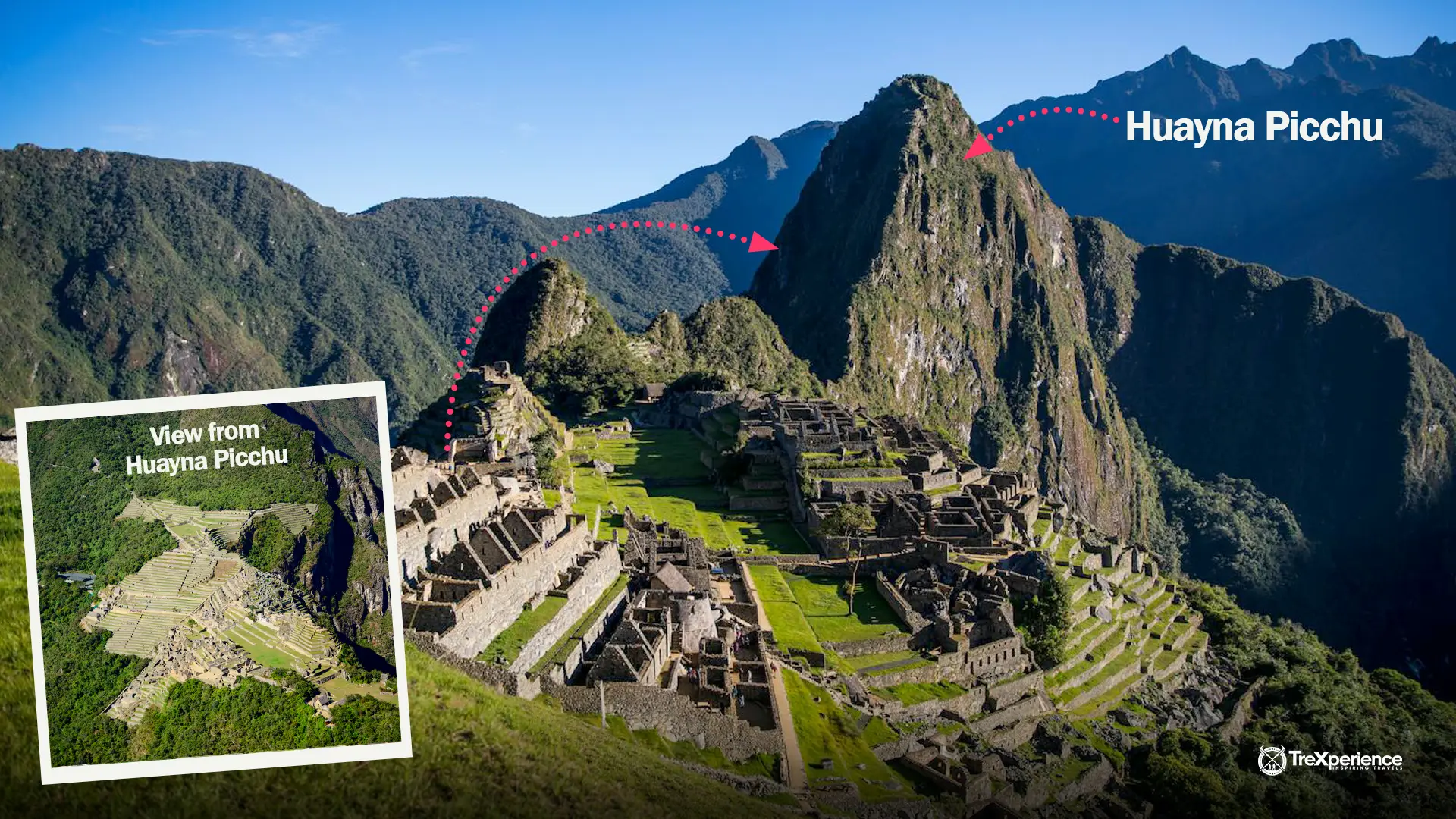
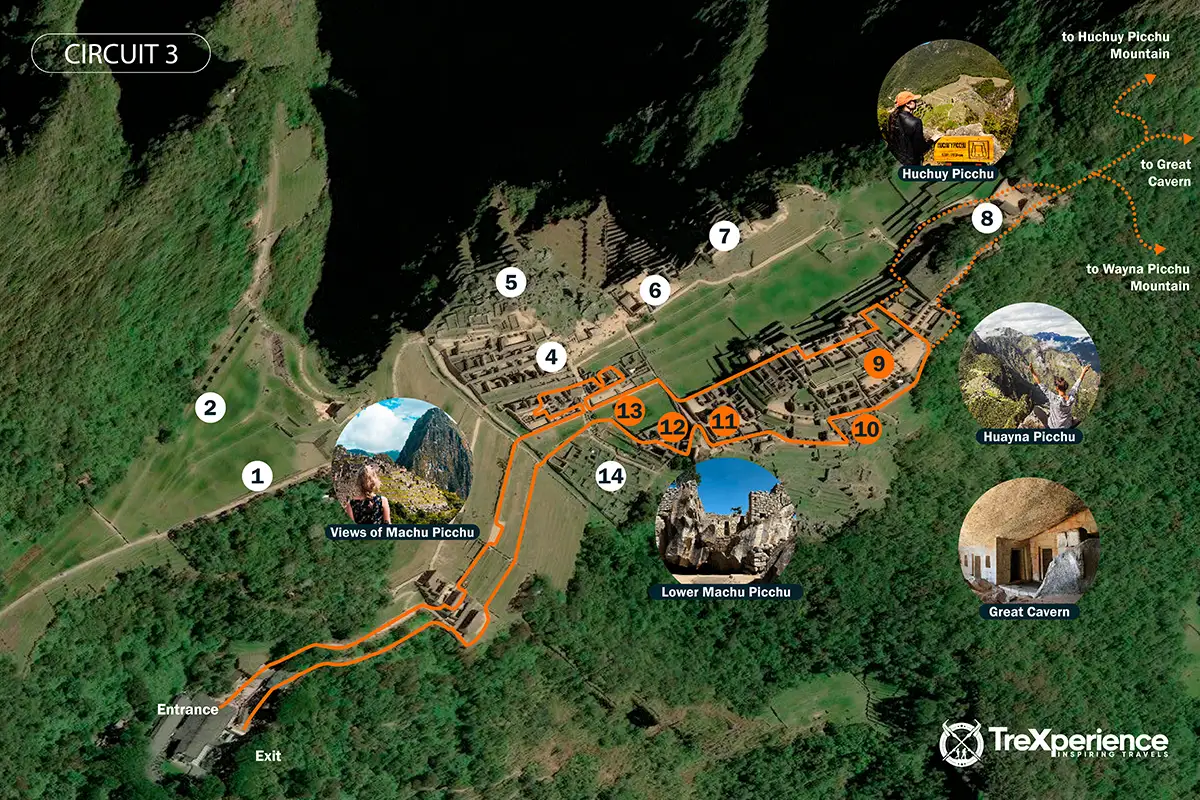
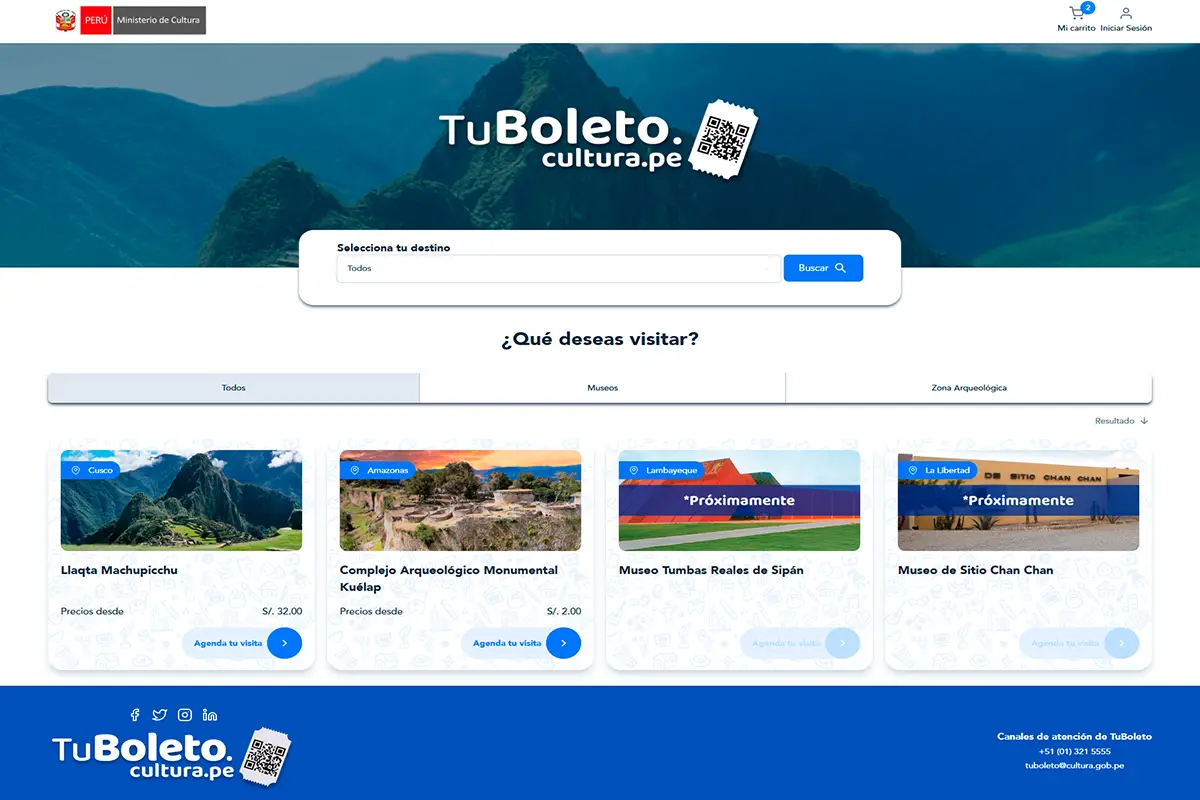

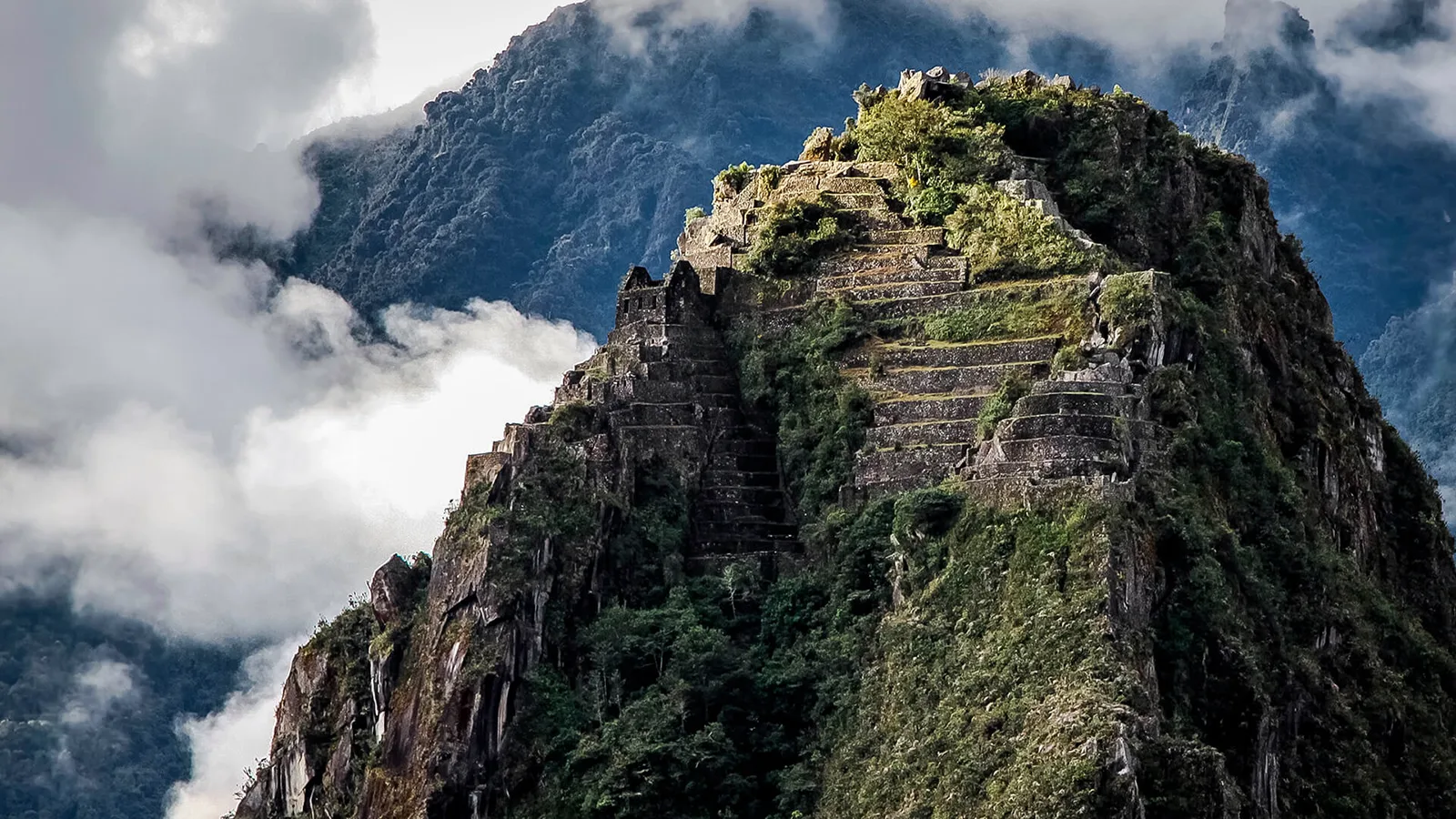
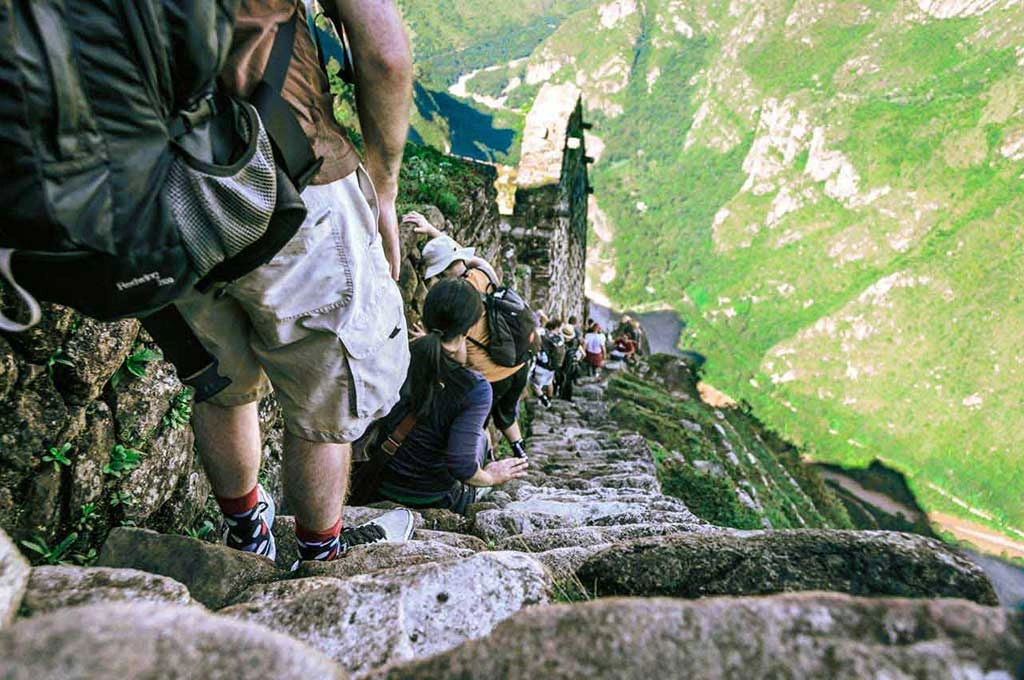
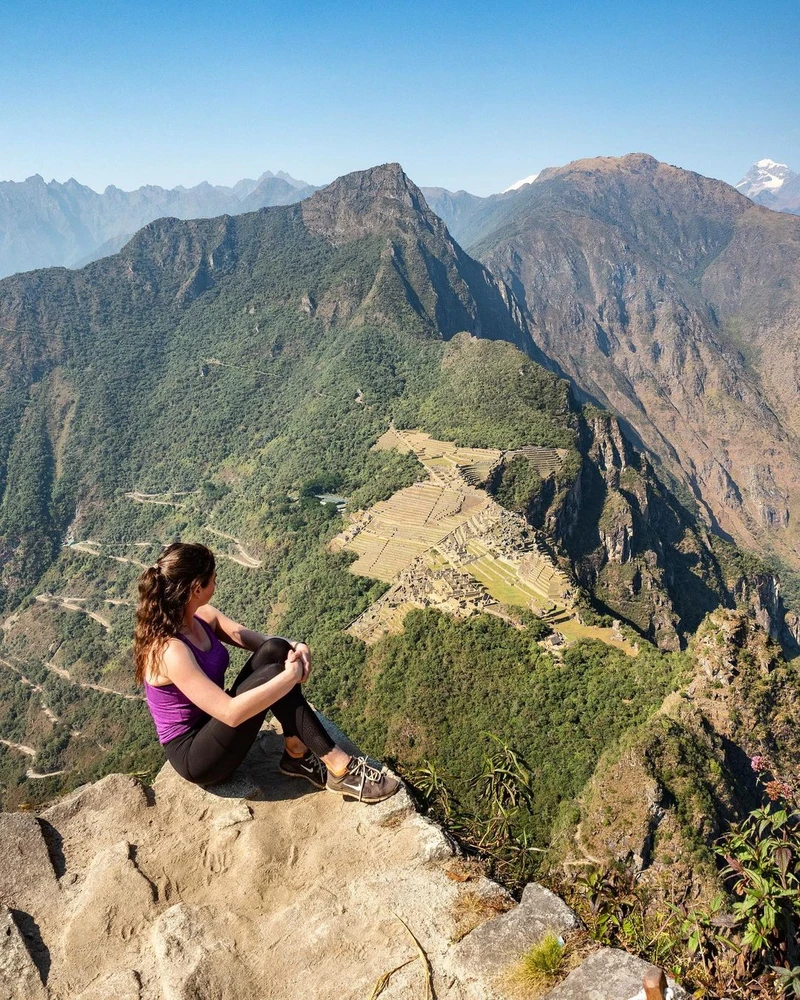


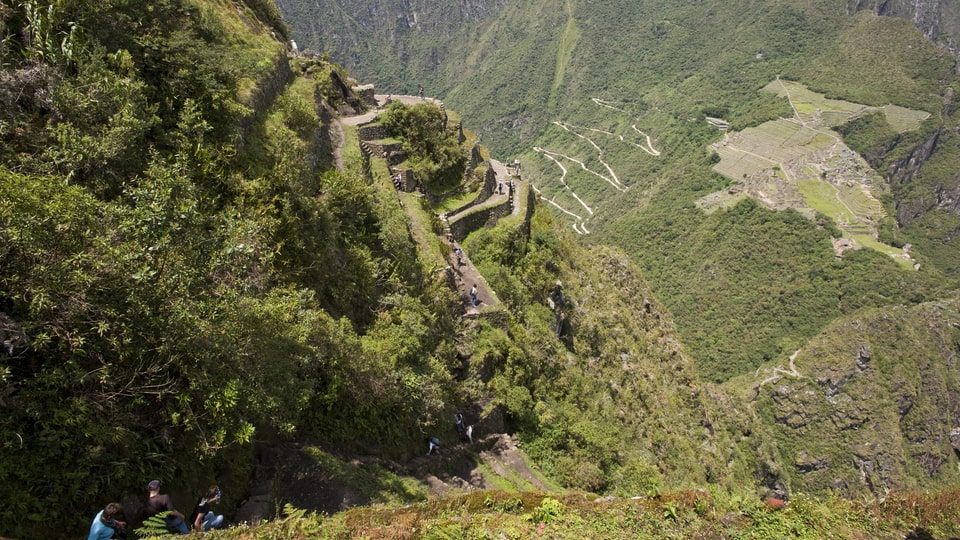
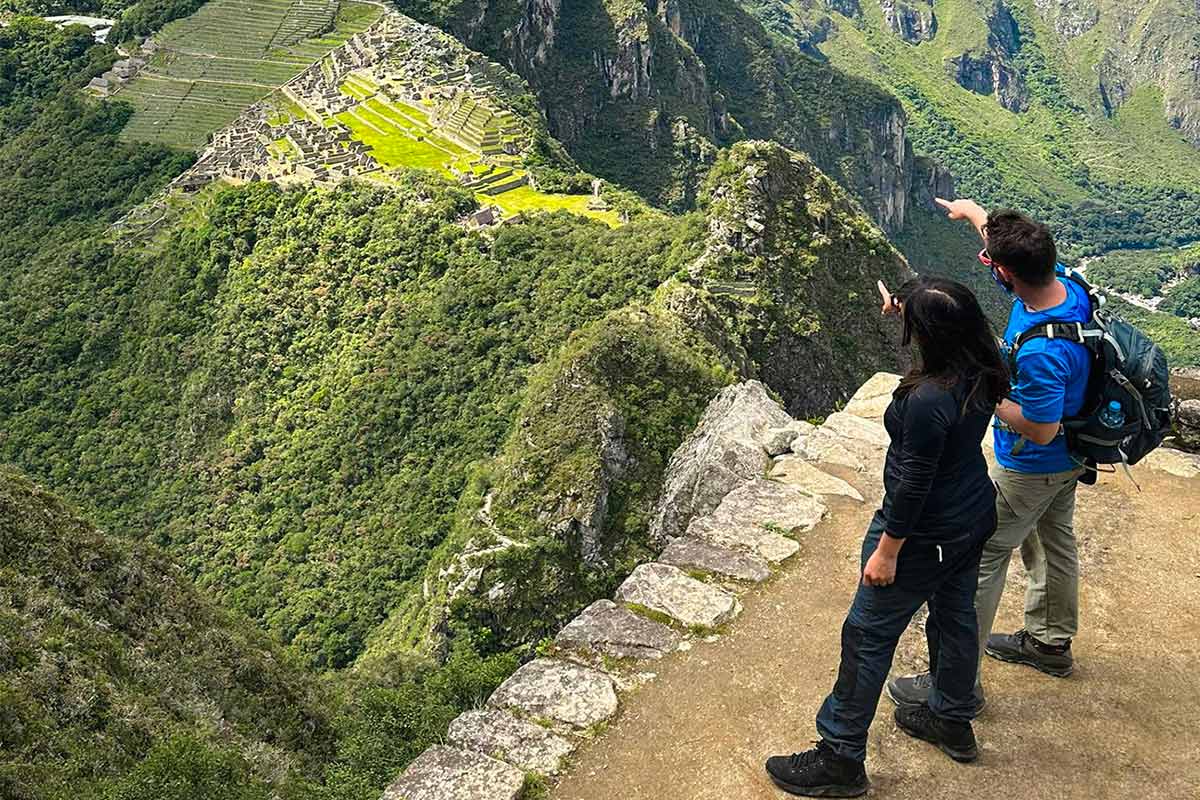
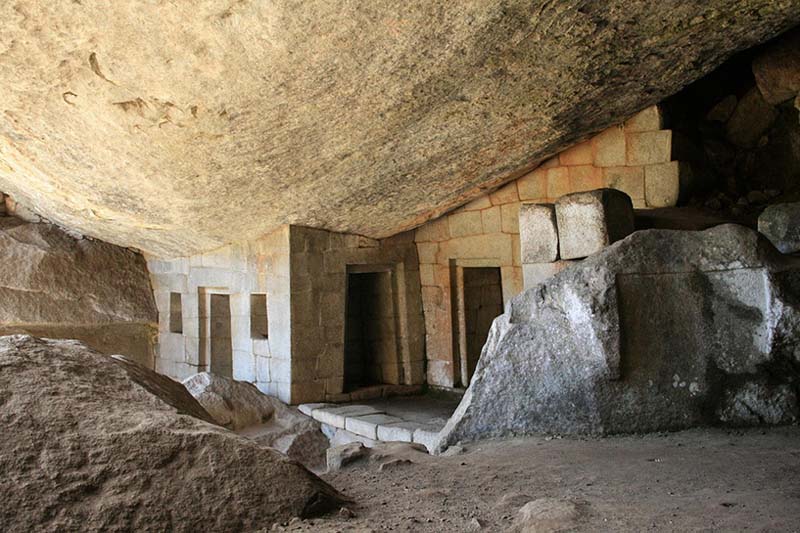
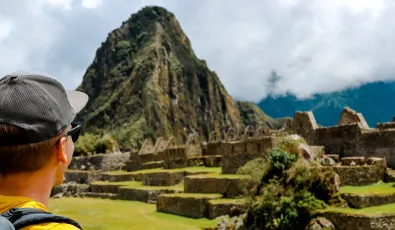
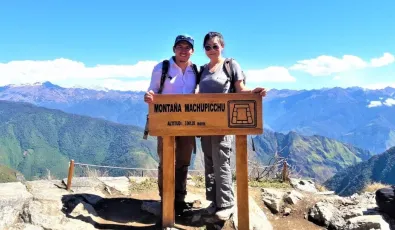
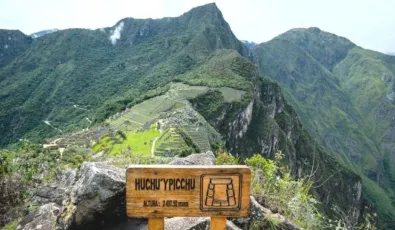

Añadir nuevo comentario